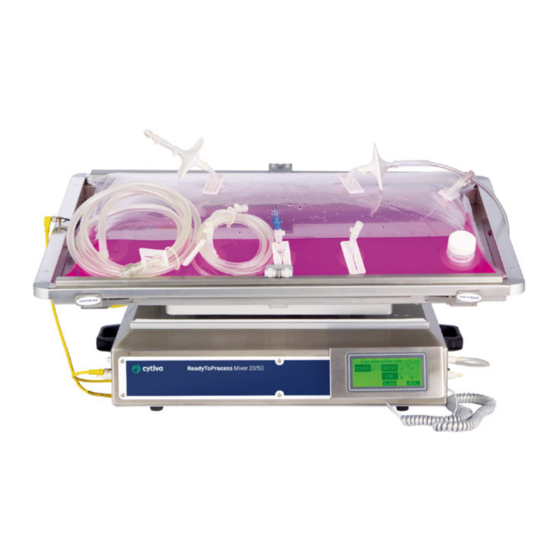
Summarization of Contents
1 Introduction
1.1 Important User Information
Read this before operating the product and understand definitions of safety notices and typographical conventions.
1.2 WAVE System Configurations
Overview of different WAVE system sizes and configurations for controlling culture parameters.
1.3 Stand-alone Instruments
List and descriptions of available stand-alone instruments for WAVE Bioreactor systems.
1.4 Control Software
Information on embedded software for control and supervision of WAVE system stand-alone instruments.
1.5 Literature
References to other manuals for further information on WAVE Bioreactor and WAVEPOD II.
2 Safety Instructions
2.1 Safety Precautions
General, personal, installation, operation, and maintenance safety precautions for WAVE stand-alone instruments.
2.2 Labels and Symbols
Description of product nameplate and safety/regulatory labels attached to the product.
2.3 Emergency Procedures
Instructions for emergency shutdown of a WAVE instrument and actions in case of power failure.
3 Common Process Controllers
3.1 Functions
Description of the main functionality of integrated Process controllers for stand-alone instruments.
3.2 Process Controller Types
Table showing stand-alone instruments categorized by large and small Process controllers.
3.3 Changing Process Controller Parameters
Procedure for changing setpoint values on Process controllers, with caution for qualified personnel.
4 DOOPT20 Dissolved Oxygen Monitor
4.1 Introduction and View
Overview of the DOOPT20 instrument, its parts, and DOOPT probes.
4.2 Installation
Instructions and requirements for installing the DOOPT20 dissolved oxygen monitor.
4.3 Operation
Instructions for operating the DOOPT20, including connecting the probe and initial display readings.
4.4 Maintenance
Procedures for maintaining the DOOPT20 instrument, including frequency, cleaning, calibration, and repair.
4.5 Troubleshooting
Common error symptoms, possible causes, and corrective actions for the DOOPT20 monitor.
5 CO2MIX20 CO2/Air Controller
5.1 Introduction and View
Overview of the CO2MIX20 instrument, its function, and main parts.
5.2 Installation
Instructions and requirements for installing the CO2MIX20 CO2/air controller.
5.3 Operation
Instructions for operating the CO2MIX20 as an aeration pump or CO2/air mix controller.
5.4 Maintenance
Procedures for maintaining the CO2MIX20 instrument, including frequency, cleaning, calibration, and repair.
5.5 Troubleshooting
Common error symptoms, possible causes, and corrective actions for the CO2MIX20 controller.
6 CO2MIX20-R CO2/Air Controller
6.1 Introduction and View
Overview of the CO2MIX20-R instrument, its function, and main parts.
6.2 Installation
Instructions and requirements for installing the CO2MIX20-R CO2/air controller.
6.3 Operation
Instructions for operating the CO2MIX20-R as an aeration pump or CO2/air mix controller.
6.4 Maintenance
Procedures for maintaining the CO2MIX20-R instrument, including frequency, cleaning, calibration, and repair.
6.5 Troubleshooting
Common error symptoms, possible causes, and corrective actions for the CO2MIX20-R controller.
7 O2MIX20 O2/Air Controller
7.1 Introduction and View
Overview of the O2MIX20 instrument, its function, and main parts.
7.2 Installation
Instructions and requirements for installing the O2MIX20 O2/air controller.
7.3 Operation
Instructions for operating the O2MIX20 as an aeration pump or O2/air mix controller.
7.4 Maintenance
Procedures for maintaining the O2MIX20 instrument, including frequency, cleaning, calibration, and repair.
7.5 Troubleshooting
Common error symptoms, possible causes, and corrective actions for the O2MIX20 controller.
8 O2MIX20-R O2/Air Controller
8.1 Introduction and View
Overview of the O2MIX20-R instrument, its function, and main parts.
8.2 Installation
Instructions and requirements for installing the O2MIX20-R O2/air controller.
8.3 Operation
Instructions for operating the O2MIX20-R as an aeration pump or O2/air mix controller.
8.4 Maintenance
Procedures for maintaining the O2MIX20-R instrument, including frequency, cleaning, calibration, and repair.
8.5 Troubleshooting
Common error symptoms, possible causes, and corrective actions for the O2MIX20-R controller.
9 PUMP20 Peristaltic Feed/Harvest or Acid/Base Pump
9.1 Introduction and View
Overview of the PUMP20 peristaltic pump, its intended use, and main parts.
9.2 Installation
Instructions and requirements for installing the PUMP20 peristaltic pump.
9.3 Operation
Instructions for operating the PUMP20, including tubing setup and speed control.
9.4 Maintenance
Procedures for maintaining the PUMP20, including frequency, cleaning, and pumphead tensioning.
9.5 Troubleshooting
Common issues and corrective actions for the PUMP20, such as power or speed problems.
10 Reference Information
10.1 Specifications
Technical specifications for DOOPT20, CO2MIX20, CO2MIX20-R, O2MIX20, O2MIX20-R, and PUMP20.
10.2 Recycling Information
Information on product decontamination, disposal, and recycling of hazardous substances and components.
10.3 Regulatory Information
Lists regulations and standards applicable to the product, including EU, North America, and CE marking.
10.4 Ordering Information
Information on how to order products, with a link to cytiva.com/wave.
Appendix A Communications and Data Acquisition
A.1 Overview
Description of analog and digital data communication options built into stand-alone instruments.
A.2 Analog/Alarm Port
Details of the 8-pin mini-DIN jack for analog signals and alarm contact.
A.3 Analog Signals
Table showing available analog signals, their voltage ranges, spans, and default module assignments.
A.4 Alarm Contact
Information on the unit alarm, its dry contact functionality, and conditions triggering the alarm.
A.5 Digital Communication Protocol
Parameters and protocol for digital communication, including baud rate and MODBUS RTU.
A.6 Communication Wiring
Information on daisy-chaining units for RS-485 networks and MODBUS cable pinout.
A.7 Digital Instrument Addressing
Guidelines for configuring unique RS-485 MODBUS addresses for connected instruments.
Appendix B DOOPT20 Measurement Theory
B.1 Introduction
Introduction to the DOOPT20's use in monitoring dissolved oxygen and its operational principle.
B.2 Measurement Theory
Explanation of the luminescence decay time and phase-angle modulation techniques used for measurement.
B.3 Effect of Temperature
How temperature affects luminescence decay time, intensity, and oxygen solubility.
B.4 Measurement Range
Details on the oxygen measurement range, phase resolution, accuracy, and temperature range.
B.5 Cross-sensitivity
Information on cross-sensitivity, particularly for CO2, and the role of saline in Oxywell2.
B.6 Response Time
Data on the response time of the DOOPT probe under various conditions.
B.7 Stability
Information on probe stability, sampling frequency, and drift due to photo-bleaching.





Need help?
Do you have a question about the WAVE Bioreactor 20/50 and is the answer not in the manual?
Questions and answers